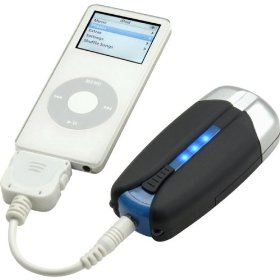
Commercial Packs using batteries ezGear makes the 4 AA PowerStick which charges the iPod's battery so it doesn't have to be connected all the time ($33, $22 in most browsers you can see a product preview of things at Amazon with the latest price by holding your cursor over the link). Griffin offers the Tunejuice 2, which uses 4 AAA batteries, ($30, $14) and only powers a partially charged iPod instead of charging the iPod's battery.

|
| Turbo Charge 2 AA Pack |
Rechargeable all-in-one packs
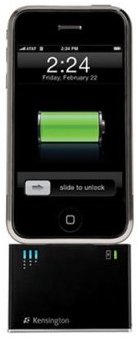
|
| Kensington Mini |
USB Chargers There are a number of chargers out there with a USB port that supplies power. Then you just connect your iPod cable to the USB port and can charge. The problem is that not all of these are compatible with every model of iPod, so make sure you confirm any USB charger will work with your model iPod before buying. The advantage is that these will usually charge other things you have that can be powered from a USB port, like a cell phone, PDA, or lesser MP3 player. Kensingon has one for $35. Macally has something similar ($39). The Battery Adapter Pro includes a LED flashlight and is powered by 4 AA batteries, $23.
Solar Power For the ultimate in post-apocalyptic personal audio power, you can get a solar-powered Solio iPod charger for $99 ($99 at Amazon), but be warned it takes a day of sun to get a few hours of play time. A "hybrid," it uses solar (or included AC adapter) power to charge its internal battery and then charges the iPod. Another model, the Solio Hybrid 1000 ($50), does not have the folding petals.
The SolarFilm AA/USB charger ($90) can charge 2 AA batteries (the batteries then provide USB power; they also have a non-USB version that charges 4 AA batteries). Unlike some of the ones with pretty tiny solar cells, this one folds out and should have enough area and amperage to charge up in a day.
With any of these, make sure you get a version with an iPod plug that supports your model.
Disposable battery pack Cellboost makes an inexpensive power pack that will recharge the iPod. It connects to the dock on the bottom of most iPods and they claim 8 hours of extra play time on iPods and minis ($3 at Amazon). Richard bought one and said there seem to be 8 AAA batteries soldered inside. He was able to get the connector and circuit board out, connect his own battery holder, and make a charger.
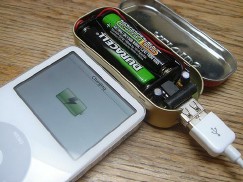 Homemade USB Chargers Newer iPods charge via USB ports which require a constant 5 volt power supply. Jeff McFadden made an iPod Shuffle charger that does this by wiring a voltage regulator that takes 7+ volts in and gives you 5 volts out to a 9-volt battery, but it isn't very efficient since it is wasting the extra voltage as heat. Still, for a Shuffle or nano it should work fine, and should provide a few hours of audio time to others. The tricky thing with any USB charger is getting exactly 5 volts and getting the correct setting on the other two USB pins (dead, connect to negative, connect to positive, connect to each other, or include resistors and then to positive). This is why some USB chargers don't work with iPods.
Homemade USB Chargers Newer iPods charge via USB ports which require a constant 5 volt power supply. Jeff McFadden made an iPod Shuffle charger that does this by wiring a voltage regulator that takes 7+ volts in and gives you 5 volts out to a 9-volt battery, but it isn't very efficient since it is wasting the extra voltage as heat. Still, for a Shuffle or nano it should work fine, and should provide a few hours of audio time to others. The tricky thing with any USB charger is getting exactly 5 volts and getting the correct setting on the other two USB pins (dead, connect to negative, connect to positive, connect to each other, or include resistors and then to positive). This is why some USB chargers don't work with iPods.
Ladyada built the MintyBoost charger using 2 AA batteries with some voltage-boosting electronics that offers 1 full recharge of a full-size iPod for up to 3 hours of additional video (in Altoids gum tin, left). It is more efficient than using a a linear voltage regulator with a 9-volt. She has very detailed instructions, user comments, and is selling do-it-yourself kits that include all the parts except the tin and batteries for $19.50 which beats tracking down all those parts yourself. Her latest version (2.0) charges any USB iPod, including the iPhone (earlier versions did not charge the iPhone and you will still need 2 strong batteries to make it work). You can read about my experience (positive) building one of these to charge my 3G nano with video (also works with 4G nano).
Homemade Firewire Chargers To use any of the homemade chargers below you will need to use an iPod firewire cable which uses different pins in the dock connector than a USB cable (see link). Firewire voltage can vary between 7 volts and 30 volts, so it isn't as picky as USB. iPods up to those introduced in 2007 can use firewire charging, but those introduced in 2008 lost this feature. WARNING: Do not substitute a USB port for the Firewire port in any of the designs below. You could damage your iPod.
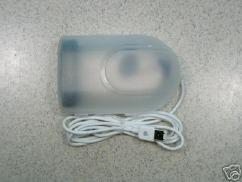 Originally, people started making their own chargers because there were few commercial options and they were pretty expensive (Belkins were $50). I don't think anyone figured out how to bypass the battery so all of these act as chargers which isn't as efficient as powering the iPod directly. Plus no one is stepping up the voltage so you have to come up with 12 volts (8 volt minimum) on your own. Saberliner77 sold a unit powered by 8 AA batteries on Ebay. He claimed five charges from the battery pack and sold it for $25 plus $7.50 shipping. Made for 1G and 2G's he charged extra for a dock connector. However you can make your own for the cost of the shipping.
Originally, people started making their own chargers because there were few commercial options and they were pretty expensive (Belkins were $50). I don't think anyone figured out how to bypass the battery so all of these act as chargers which isn't as efficient as powering the iPod directly. Plus no one is stepping up the voltage so you have to come up with 12 volts (8 volt minimum) on your own. Saberliner77 sold a unit powered by 8 AA batteries on Ebay. He claimed five charges from the battery pack and sold it for $25 plus $7.50 shipping. Made for 1G and 2G's he charged extra for a dock connector. However you can make your own for the cost of the shipping.
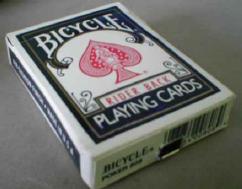 There are some variations. The first I know of was by Drew Perry who put his in a box for a deck of cards using two 9 volt batteries in parallel (doubling the amperage but still yielding 9 volts) with 2 AA batteries tacked on to get up to 12 volts. The leads from this were then soldered onto a Firewire port which was attached to hole in the bottom of the deck of cards and reinforced with cardboard.
There are some variations. The first I know of was by Drew Perry who put his in a box for a deck of cards using two 9 volt batteries in parallel (doubling the amperage but still yielding 9 volts) with 2 AA batteries tacked on to get up to 12 volts. The leads from this were then soldered onto a Firewire port which was attached to hole in the bottom of the deck of cards and reinforced with cardboard.
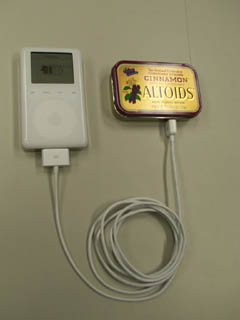 Unixmonkey (and Chris DiClerico who has more pictures, or you can use an Atari 2600 cartridge) does the same thing. He feels like that will supply more juice than 8 AA batteries, but I think the amperage is higher with 8 AA batteries (if you take the mah and multiply by volts you get milliwatt hours: 8 1800 mah 1.2V AA's give 17,280 mW-hrs, 2 120 mah 8.4V batteries plus 2 1800 mah 1.2V AA's give only 6,336 mW-hrs, a third as much juice). He puts his setup into an Altoids tin (cinnamon, yuck) with a firewire port soldered into the side which has to be heavier duty than the packs of cards. Then he can use his sync cable to hook the Altoids tin up to the iPod and charge it. Pretty neat. The problem is you have to find a Firewire port. He gives a place you can buy them. I tried to order a few from there but they never shipped them which was just as well. They were about $2 each plus $4 postage. Some people have had luck using the 6-pin to 4-pin adapter that came with iPod (which they weren't using anyway) and tearing it up to extract the 6-pin port. One guy had tried the Firewire port but had oversoldered or something and wound up frying his iPod so that's another reason to avoid having to do the skilled soldering work. Here's a diagram of a firewire port where Pin 1 is + and Pin 2 is -.
Unixmonkey (and Chris DiClerico who has more pictures, or you can use an Atari 2600 cartridge) does the same thing. He feels like that will supply more juice than 8 AA batteries, but I think the amperage is higher with 8 AA batteries (if you take the mah and multiply by volts you get milliwatt hours: 8 1800 mah 1.2V AA's give 17,280 mW-hrs, 2 120 mah 8.4V batteries plus 2 1800 mah 1.2V AA's give only 6,336 mW-hrs, a third as much juice). He puts his setup into an Altoids tin (cinnamon, yuck) with a firewire port soldered into the side which has to be heavier duty than the packs of cards. Then he can use his sync cable to hook the Altoids tin up to the iPod and charge it. Pretty neat. The problem is you have to find a Firewire port. He gives a place you can buy them. I tried to order a few from there but they never shipped them which was just as well. They were about $2 each plus $4 postage. Some people have had luck using the 6-pin to 4-pin adapter that came with iPod (which they weren't using anyway) and tearing it up to extract the 6-pin port. One guy had tried the Firewire port but had oversoldered or something and wound up frying his iPod so that's another reason to avoid having to do the skilled soldering work. Here's a diagram of a firewire port where Pin 1 is + and Pin 2 is -.
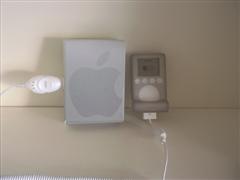 Juniperlater built something similar with the same battery configuration but instead of using a Firewire port he connected them to a car lighter socket. Then he could hook up a car adapter cord to charge the iPod. At the time that wouldn't work for me, but then I got a Griffin Powerpod car adapter ($10 at Amazon) (which I recommend because it also comes with a spare firewire charging cable; the PowerJolt is the same thing but with a USB port and cable, $16, that kit plus a wall adapter is $26) so that seemed a good way to go. Juniperlater used alligator clips to hook up to his socket so he didn't have to solder anything. He pointed out that he could use the contraption to recharge his cell phone as well (or a Palm).
Juniperlater built something similar with the same battery configuration but instead of using a Firewire port he connected them to a car lighter socket. Then he could hook up a car adapter cord to charge the iPod. At the time that wouldn't work for me, but then I got a Griffin Powerpod car adapter ($10 at Amazon) (which I recommend because it also comes with a spare firewire charging cable; the PowerJolt is the same thing but with a USB port and cable, $16, that kit plus a wall adapter is $26) so that seemed a good way to go. Juniperlater used alligator clips to hook up to his socket so he didn't have to solder anything. He pointed out that he could use the contraption to recharge his cell phone as well (or a Palm).
I bought an 8 AA battery holder (Radio Shack part 270-387, $1.99) and a 9V connector ($1) from Radio Shack. Then I got a lighter socket from Auto Zone ($3). I already had a bunch of unused AA NiMH batteries from my Archos Jukebox so I didn't need to buy batteries. I soldered the leads from the 9V connector to the lighter socket. The red lead (positive) attached to the center or tip of the lighter socket and the black lead (negative) attaches to the outer shell of the lighter socket. The lighter socket fits into a hole I cut in the side of a Band Aids can and is held in place with a screw-on piece that it comes with. I put some pieces of foam on the sides of the socket to provide some additional support and put the battery holder in loose on top. That way it is all self-contained and I can plug the Powerpod into the side. Even though NiMH batteries are nominally 1.2 volts, not 1.5, that still gives me 9.6 volts. And when they are fully charged I get about 11 volts (there is a 0.7 volt drop across the PowerPod due to its diode but there is an advantage to that described later). In one test (see link below) I got 7.8 hours out of the iPod, but with 5 hour-long charges I got 27.7 hours of total playing time. It's not as efficient as the Belkin battery pack because you're losing power going through the iPod battery, but it's cheap and doesn't always have to be connected. And I like that it fit in some household consumer container like a Band Aids can like the earlier ones do. Different devices and newer iPods can be charged by upgrading the car charging cable and adapter.
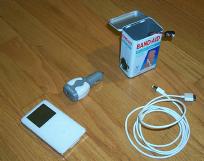 |
 |
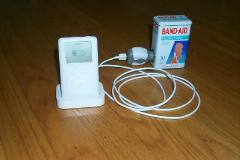 |
After I built mine I wasn't as interested in what else was going on, but some neat solutions came along. The first was made by a iLounger named tanakasan who actually formed a white resin header for the top of the battery holder that had the firewire port incorporated into it. 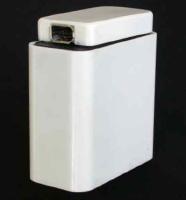 He took it one step further by making a white resin case to slide the batteries and holder into. He sold some of these in the classifieds section there and on E-bay, but I don't think he's making them anymore. On Ebay they were about $40.
He took it one step further by making a white resin case to slide the batteries and holder into. He sold some of these in the classifieds section there and on E-bay, but I don't think he's making them anymore. On Ebay they were about $40.
At some point there was some discussion on the battery pack getting low enough on a charge that the iPod would start leaking its charge to the battery pack. This is a different behavior from what I saw in my test where the battery pack would go below the threshold for charging the iPod and then go back up above the threshold and start charging again. Either way I don't think you want to leave the iPod hooked up to the charger indefinitely, but people started incorporating diodes into their chargers. A diode always drops the voltage though so it seems like you would get fewer charges. As it turns out, the PowerPod car adapter I'm using has a fuse and a diode in it so my setup protects against surges and back flow. I thought the drop would give you fewer charges, but by the time the battery pack gets down to 0.7 volts above the iPod charging threshhold the batteries are pretty much shot anyway. NiMH batteries drop off quickly towards the end of their run cycle. For homemade chargers the diode really complicates things and if you're careful I don't know that you need it.
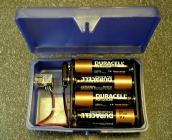 A couple of people found soap dishes that held the batteries. Kloan made a nice one and sold them for a while until he couldn't find a supply of the soap dishes. His was nice because there was room left over in there to hold the Firewire cable. Tye made a similar one with a more readily available soap dish from the Walmart camping department.
A couple of people found soap dishes that held the batteries. Kloan made a nice one and sold them for a while until he couldn't find a supply of the soap dishes. His was nice because there was room left over in there to hold the Firewire cable. Tye made a similar one with a more readily available soap dish from the Walmart camping department.
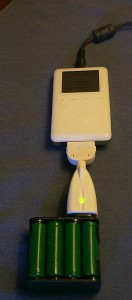 A thing showed up called an Emergency Charger (link, picture). I found them available from eBay user Colordrives in December 2005 for $0.99 plus $6.45 shipping and wrote up a review and test results, but the bottom line is the 9-volt battery didn't work at all charging my 3G iPod. However if you connect the 8-AA (or 6-AA) battery pack instead of a 9-volt it makes for a very simple and inexpensive iPod charger.
A thing showed up called an Emergency Charger (link, picture). I found them available from eBay user Colordrives in December 2005 for $0.99 plus $6.45 shipping and wrote up a review and test results, but the bottom line is the 9-volt battery didn't work at all charging my 3G iPod. However if you connect the 8-AA (or 6-AA) battery pack instead of a 9-volt it makes for a very simple and inexpensive iPod charger.
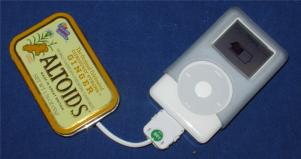 Another iLounger named Syzygies found a dock connector at Radio Shack called the iTips Smart Connector B01 (Part No. 273-1952, $10) that allowed you to run a charger directly to the dock connector. His first effort only used 6 AA batteries. Then he used 7 AAA batteries in a Altoids tin (Ginger! even worse!). Then he went back to AA batteries but incorporated some electronics so you could charge the NiMH batteries without taking them out. He uses 7 AA batteries and puts his electronics in the place where the 8th battery would have gone. It's a neat solution, but just taking apart the B01 connector to attach a permanent cord looks kind of intimidating let alone messing with all the other stuff.
Another iLounger named Syzygies found a dock connector at Radio Shack called the iTips Smart Connector B01 (Part No. 273-1952, $10) that allowed you to run a charger directly to the dock connector. His first effort only used 6 AA batteries. Then he used 7 AAA batteries in a Altoids tin (Ginger! even worse!). Then he went back to AA batteries but incorporated some electronics so you could charge the NiMH batteries without taking them out. He uses 7 AA batteries and puts his electronics in the place where the 8th battery would have gone. It's a neat solution, but just taking apart the B01 connector to attach a permanent cord looks kind of intimidating let alone messing with all the other stuff.
If you have anything to add to this guide please contact me and I will revise the guide as needed. Thanks.